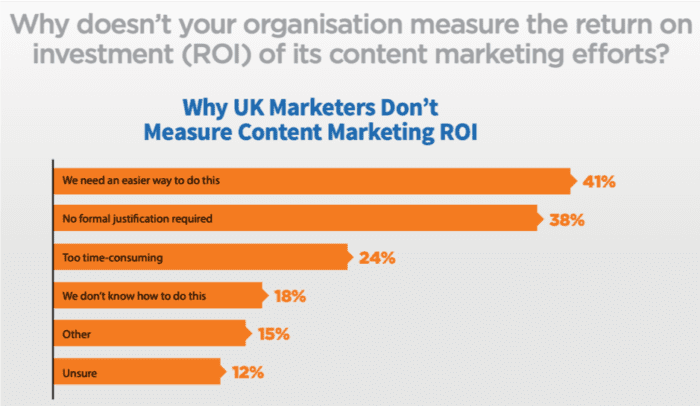In order to drive commitment levels, your content marketing campaigns need to be successful
Research from The Content Marketing Institute found that 26% of companies’ content marketing services are in the adolescent phase and 34% are in the first steps phase.
Only 50% of respondents described their organization’s commitment levels to content marketing as very or extremely committed.
In order to drive commitment levels, your content marketing campaigns need to be successful. The problem is, it can be easy to make mistakes during the process, which can cost you links, shares, traffic and conversions.
Here, we’ll discuss the five main mistakes made in the content marketing process, the impact those mistakes are having, and how you can resolve them to make sure your next campaign is a success.
The ideation process
The mistake
The ideation process can be hard, as you’ll need to come up with an idea that your target market finds engaging and interesting, whilst serving a purpose.
The problem is, it can be so easy to come up with “bad” ideas. For example, if you’re sitting at your desk trying to think of your next great idea; chances are it isn’t going to be the campaign that wins you (or your client) links and coverage.
Other surefire ways to come up with bad ideas include basing your content on seasonality or making it too branded. For example, let’s say you work at a digital marketing agency, and you want to create a content marketing campaign for your client, who runs outsourced call centres.
Whilst sitting at your desk, you decide you’re going to create an infographic titled “The ten biggest call centres in the UK”. The mistake? Well, while your client may think it’s a great idea, your target audience won’t be interested in finding out about the ten biggest call centres – it’s too branded, and it doesn’t serve a purpose.
The impact
So, what’s the impact of bad ideas on your content marketing project? It’s simple: you’ve essentially set the project up to fail.
Although you’ve invested a lot of time and money into creating a content marketing piece, the idea doesn’t resonate with your target audience, meaning no one will read it, no one will share it, and no one will link to it.
The solution
You need to stop having “bad” ideas. First thing’s first, if you’re guilty of trying to be creative whilst sat at your desk, then step away. Run a content ideation session with a group of colleagues where you can bounce ideas off each other.
Run the ideation session in a breakout space in the office – or even better, go for a walk. The last thing you want is a stuffy atmosphere where people are too embarrassed to share their ideas because often, it’s the “silly” ideas that are the best ones.
Continuing with the example of the outsourced call centre company again, you’ll soon find the ideation session can help you to come up with creative ideas that are genuinely interesting. How much better does commissioning a survey to see how people across the UK view regional accents sound, compared to the original infographic idea?
Statistics such as 84% of the UK population find the Geordie accent to be the most friendly, or 12% of people can’t understand a Glaswegian accent, will work well if your goal is to build links. These stats will work great as headlines in regional media, because of how relatable the content is.
Once you’ve chosen your content marketing idea, sense-check it outside your office, so you can get genuine feedback. One great way to do this is by putting the idea out on Reddit, so users can feedback.

Thinking content has to be new
The mistake
When it comes to the ideation process, a lot of marketers think they have to come up with a totally new idea. The reality is, unless you’ve undertaken a ground-breaking piece of new research, your idea will most definitely have been done before.
If you work in an agency, you may have created a piece of content for a previous client that you know will work well for your current one. Don’t disregard this opportunity either, as you can rework it.
The impact
Ultimately, if you think your idea has to be new, then you’re throwing away other, potentially great ideas that could have gained you additional traffic and links.
If you spent your time trying to come up with a completely new idea, and it turns out to be “bad”, then you’ve wasted the time and money invested in this project.
Alternatively, if you give up the whole idea of creating a content marketing campaign because you couldn’t think of a new idea, then you’ve lost out on the chance of running a successful campaign and gaining a case study. No matter whether you’re working at an agency or in-house, those case studies are crucial to giving you the opportunity to conduct another content marketing campaign in the future.
The solution
The solution is simple when it comes to content ideas that already exist: you just need to make yours better.
This could mean including more information, incorporating up-to-date statistics, or creating a slick, user-friendly design.
For example, let’s say you work in-house for a company that organizes hen parties. Your idea is to create a piece of content about the best hen party destinations in the UK. However, a Google search has returned hundreds of similar blogs.
Do you scrap that idea? No, you simply make it better. Obviously, the amount of budget, time and resources you have will depend on your capabilities. Taking that out of consideration, instead of creating another blog similar to the hundreds out there already, you could create an interactive map instead. Users would click on a city, and find a list of hotels, bars, restaurants, clubs and activities to do during their hen party in that area.
Not only can this help to increase traffic to your site and shares to your content, because of all the information you’ve provided the reader with; but it also gives you the opportunity to build link partners, by reaching out to the companies you’ve mentioned in each city.
Communication issues
The mistake
The content marketing process is likely to involve many people: the project manager, copywriter, designer, potentially a developer, the PR team, and the client.
Bad communication between any of these channels can have a huge negative impact on your content marketing campaign.
For example, if you fail to give a proper brief to the designer or copywriter, then you could end up with a piece of creative that you don’t want, or you could miss the deadline.
Alternatively, if the communication issue is between you and the person who’s signing off, then it could throw the whole project off track.
The impact
The best case scenario is a minor negative impact, but the worst case scenario is you could end up with a content marketing campaign that doesn’t deliver the objectives.
Project management is difficult, but if you’re the person reporting back to the client, then you’re responsible for explaining the failings behind the project.
If your content marketing campaign takes much longer to deliver than anticipated due to communication issues, then it could lose momentum, resulting in a loss of valuable extra traffic, links and shares.
The solution
You need to get every single stakeholder onboard with your content marketing project. Hold a meeting for the key internal people, where you can highlight the importance of content marketing projects for the client, and the benefits it’ll bring so that everyone is working towards a common goal.
Is it your client, or the person you need sign off from, that you’re struggling to get in touch with? If you’ve emailed them over the creative to get feedback, arrange a follow-up call and set them a deadline for feedback. For example, ending your call or email with: “If I haven’t heard back from you by the end of the week, I’ll proceed with publishing and outreaching this content” should spur them on to get in touch with you if they do have any issues.
Not tracking results
The mistake
Research conducted by The Content Marketing Institute found that 36% of marketers don’t measure their content marketing results. The two top reasons for this were because they either needed an easier way to do this (41%), or they weren’t required to show formal justification (38%).
Whilst 83% of respondents said they could demonstrate with metrics how content marketing has increased audience engagement, only 34% said they could demonstrate how it’s decreased the cost of customer acquisition.
In total, only 45% of respondents said they measure the ROI from their content marketing. 36% said they didn’t, and 19% were unsure.
The impact
The impact this has is clear: it could be costing you future campaigns.
Even if as a marketer, you think you don’t need formal justification; there will come a point where, in order to proceed with content marketing as an ongoing project, you’ll need to justify the output.
If you can’t show how your content marketing has improved engagement, built backlinks and brand awareness, increased your rankings in the SERPs, and ultimately, driven conversions and sales; then it’s highly unlikely you’ll have the chance to carry out more content marketing campaigns.
The solution
Get out of the mind frame of not tracking your results because you don’t think you need to, and start looking at the successes your hard work has driven.
If you’re unsure of how to track your content marketing campaigns, then give these four tools a try:
Google Analytics
Track traffic to your website via your content marketing campaign by checking the number of visits to that page in the behaviour report.
You can also see how traffic arrived on that page – e.g. via organic search, referral, social media or PPC, so you can see which channel your campaign performed the best.
SEMrush
SEMrush is my preferred keyword tool, but there are several other tools that you can use to track keyword positioning too.
Whilst ranking for keywords may not be your number one priority, you should still optimize your content, as it will help to bring in extra traffic, and potentially new leads.
Buzzsumo
Buzzsumo’s content analyzer means you can analyze the content on your website to see how well your content marketing campaign performed in terms of links and engagements on social media.
This is great for showing brand awareness and engagement levels, but it’s also a good source for new ideas too, as you can see which content worked well for your competitors.
Ahrefs
Ahrefs enables you to track backlinks that have linked through to your content marketing campaign.
The Domain Rating (DR) shows you the quality of links you’re getting, and you can also see the anchor text. If it’s something generic like “click here”, you may want to get in touch with the publisher and request they change it to a keyword that you’ve optimized your content for.
Not learning from previous results
The mistake
If you don’t review your results, then you won’t learn from any mistakes you’ve made, as you won’t know they even exist.
If you don’t get any links, or if no one is converting to a lead from your content campaign, then the worst thing to do is ignore it, and move onto your next project. You need to put some time aside to figure out the reason behind the failings, so you know how to rectify them going forward.
The impact
The impact – like all the other mistakes listed – will affect your success. Without looking into what caused the mistakes, you won’t learn from them, meaning you’re likely to make the same mistakes in future content marketing campaigns.
The more failed campaigns you run, the less likely you’ll be able to continue with them in the future, as you’ll have wasted time, money and resources on a project that you don’t have anything to show for.
The solution
Realistically, the only way you can learn from previous content marketing campaigns (whether results were positive or negative) is to analyze exactly what happened every step of the way during the project.
Gather your team together and answer the following:
- Was our idea actually interesting and engaging, or was it just interesting to us?
- How was the communication between teams? Did everything run according to plan, or did we run into any communication issues? What was the result of those issues?
- Did we get the links we wanted? Did we target the right publications? Did we promote it on social enough? Did we optimize the page we posted the content on?
By working out what went well and what didn’t, you can start to hone the content marketing process every time you start a new project. If a campaign has been particularly successful, create a case study to get new clients on board, and to persuade your company that content marketing is worth the investment.
Final thoughts
The early stages of content marketing are the most difficult, as you’ll encounter issues and make mistakes along the way. However, the only way to rectify mistakes in future campaigns is to acknowledge what went wrong and work out how they can be resolved.
If you’re guilty of making these five mistakes, it’s imperative you consider the impact it’s having on your efforts, and how it could be holding back your content in the future. Take the time to figure out how to resolve the previous mistakes you’ve made so that your next content marketing campaign can be a success.

